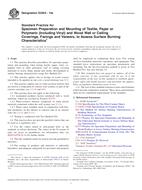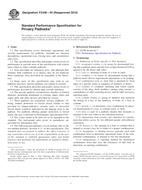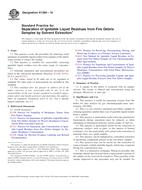1.1 This guide along with Guide E 1192 and guidance from the U.S. Environmental Protection Agency (1,2) covers the use of resident species in toxicity testing, particularly if site-specific information is desired. For example, in those systems where particular species are considered to be economically or aesthetically important, it might be more appropriate to utilize resident species for testing (3). For this reason, the USEPA allows development of site-specific chemical standards, using resident species, in order to reflect local conditions (1). This guide is designed to guide the selection of resident species for use as test organisms in aquatic and sediment toxicity tests. It presupposes that the user is familiar with the taxonomy of aquatic and benthic species and has some field experience.
1.2 Because toxicological information is often limited for many aquatic species, it is assumed that the majority of testing applications will be acute tests. Therefore, much of the guidance presented in this guide pertaining to the species selection process is applicable when acute toxicity testing is the desired goal. However, the principles discussed in this guide pertain to chronic toxicity test applications as well, although it should be clearly understood that such testing requires substantially greater effort, time, and resources than acute testing.
1.3 The procedures for selecting resident species in toxicity testing are necessarily general at this time because information is often lacking for specific taxa or groups of taxa. This guide attempts to give specific information when appropriate.
1.4 This guide is not intended to be inclusive. References listed provide a starting point from which to approach the literature. This guide deals solely with aquatic toxicity test situations. Terrestrial, arboreal, or atmospheric species ar not considered in this guide.
1.6 This standard does not purport to address all of the safety concerns, if any, associated with its use. It is the responsibility of the user of this standard to establish appropriate safety and health practices and determine the applicability of regulatory limitations prior to use. All safety precautions and health-related practices are the responsibility of the user. Specific safety practices are suggested in Section 8.
Product Details
- Published:
- 03/10/1997
- Number of Pages:
- 13
- File Size:
- 1 file , 160 KB


